Table of contents
The yam bean , tube bean , benkuang or bengkuang (also bengkoang, Pachyrhizus erosus ) occurs naturally from Mexico to South America and now also in Asia and Africa. In Mexico it is called jícama . Only the root tuber of the plant, which is low in protein and fat, is edible (also raw).
Use in the kitchen:
The consistency of the turnip-like yam bean is comparable to that of a radish - from woody to juicy. The taste of the root flesh is earthy and sweet and reminiscent of apples. Only the peeled root is edible - even raw! The other parts of the plant (except the flower) contain the more or less poisonous Rotenone and its glycosides.
In Mexico, street vendors offer jicama cut into strips with lime juice, salt and chili sauce. This is how it is known as a snack.
The root flesh, especially of young, fresh yam beans, is usually eaten raw as a salad or side dish. Yam beans that have been stored for a longer period of time are prepared like potatoes or sweet potatoes. They taste good boiled or as oven chips, in stir-fries, stews or as a puree.
Peeled and prepared yam beans will keep in a bowl of cold water and a splash of lemon juice in the refrigerator for up to two days.
Vegan recipe for avocado, yam and orange salad:
Ingredients (for approx. 6 servings): 3 tbsp olive oil (preferably cold-pressed rapeseed oil ), 1 tsp lime juice , 1 chopped garlic clove , 1 tbsp white wine vinegar , 1 tsp ground cumin, 1 tsp sea salt , 1 pinch of chili powder , 230 g yam bean (Bengkoang), 2 oranges , 1 avocado , 1 red onion , 8 pieces of romaine lettuce (Romana lettuce) .
Preparation: Peel the yam and cut into strips of about 0.5 x 3 cm, fillet the oranges, cut the avocado into pieces and the peeled onion into thin rings. For the vinaigrette, whisk all the liquid ingredients and the spices together and leave to cool briefly. In the meantime, wash the lettuce, tear it into small pieces and dry it a little with a salad spinner. If you don't have romaine lettuce to hand, you can use any other leaf lettuce. Then arrange the green lettuce leaves on plates, spread the fruit and vegetable mixture on top and pour the vinaigrette over it. Grind some fresh pepper over it if necessary.
Vegan recipes with yams can be found under the note: " Recipes that have the most of this ingredient ".
| Not only vegans or vegetarians should read this: Vegans often eat unhealthily. Avoidable nutritional mistakes . |
Shopping - where to buy?
You can't usually find runner beans in supermarket chains like Coop , Migros , Denner , Volg , Spar , Aldi , Lidl , Rewe , Edeka , Hofer etc. In Europe, you can find yam beans in some health food stores, in South American grocery stores or in very large and well-stocked supermarkets. They are rarely found in organic quality, and even organic supermarkets ( Denn's Biomarkt ) only stock them in exceptional cases, if at all.
When buying, you should make sure that the brownish skin of the runner bean is shiny rather than matte. Larger tubers are usually a bit woody. The weight of the Benkuang should correspond to its size. If large tubers are rather light, they have usually been lying around for a while and have lost moisture.
Before use, please clean, brush and peel the skin. Eating the skin can cause severe stomach pain.
Storage:
The yam bean (Bengkuang) is best stored in a dry place at room temperature (between 12 and 20 °C). Colder temperatures can damage the roots. Therefore, they should not be frozen. Stored at appropriate temperatures, the roots of the yam bean will last for one to two months.
Ingredients - nutritional value - calories:
The yam bean has about 38 kcal per 100 g. Carbohydrates make up the majority of the energy at 8.8%, of which about 5% is fiber. The fat content is barely present at 0.09%, similar to the protein at 0.72%.
Jicama contains 20 mg/100g of vitamin C. This is comparable to the values of sauerkraut or cassava . But blackberries don't really have any more of it, at 21 mg/100g. The body cannot store this water-soluble vitamin in large quantities, which is why daily intake is very important. The daily requirement for an adult is 95 (women) or 110 mg (men). 1 These requirements can be met very easily with wild garlic (150 mg/100g), peppers (184 mg/100g) or blackcurrants (181 mg/100g). Ascorbic acid is an important antioxidant and protects against free radicals. 2 Watch our video .
The potassium content of Benkuang is 150 mg/100g and is similar to that of cucumber , mung bean sprouts andraspberries . Dried herbs such as parsley (2683) or basil (2630 mg) have particularly high levels. As an essential macronutrient, potassium must be supplied through food. Among other things, it regulates the osmotic pressure in the cells, cell growth, blood pressure and acid-base balance. 2
The yam bean contains 12 µg of folic acid per 100g, while pink grapefruit and star fruit have similarly low levels. This water-soluble vitamin is very important for cell renewal. Legumes in particular have a high content of the precursor folate, such as mung beans (raw: 625; cooked: 159), chickpeas (raw: 557; cooked : 63), or lentils (raw: 479, cooked : 181). 2
In addition, other ingredients such as iron , vitamin E , magnesium , phosphorus and manganese are included in small quantities.
The complete ingredients of yam beans, the coverage of the daily requirement and comparison values with other ingredients can be found in our nutrient tables. In the article Nutrients explained you will get a detailed insight into the topic.
Health aspects - effects:
There are some contradictions in science regarding the content of rotenone in the seeds. Brücher writes: In view of the assumption repeatedly expressed in the literature that the ripe seeds contain rotenone (and are therefore inedible), we have convinced ourselves of the edibility and the attractive taste of the young pods and seeds through our own consumption. 3
Rehm and Espig describe the leaves and mature pods (including seeds) as poisonous, while young pods are said to be edible. 4
The sweet taste of the jicama bean comes from the polysaccharide inulin, which is considered a prebiotic. Studies (in an animal model) show that taking jicama extract can increase insulin sensitivity. This means that the body has to secrete less of this hormone to lower blood sugar levels. 5
Dangers - Intolerances - Side effects:
Rotenone is used as an insecticide or acaricide (mite control agent), it is mainly toxic to fish, less so to mammals and bees. The active ingredients are isoflavones, isoflavones, several rotenoids, furano-3-phenyl-coumarin. 6
According to Nature Scientific Reports, rotenone is suspected of causing Parkinson's disease, 7 which is why it is no longer approved as a substance in some European countries (such as Switzerland, Germany) (e.g. in Germany since 1987 9 ).
Occurrence - Origin:
The yam bean originally comes from Mexico and is an old Indian cultivated plant. The word jícama is Nahuatl and means "tasty". The tuber bean is now cultivated throughout the tropics and especially in Africa and Asia.
The three best known species of the genus Pachyrhizus are 3 (the naming often differs among the individual species):
- Pachyrhizus erosus Urban (L.): tuberous bean, yam-bean, patate-cochon, iguama, macucú, xicamatle (tropical lowland).
- Pachyrhizus ahipa (Wed.) Parodi: Andean tuber bean, yam-bean, jiquima de Peru (tropical mid-mountain regions).
- Pachyrhizus tuberosus (Lam.) Spreng: tuberous bean, potato bean, pois-patate, jicama (tropical lowland).
Cultivation - Harvest:
The yam bean, a climbing, perennial, herbaceous climbing plant, can reach a length of up to 5 m. The root tubers serve as survival organs; larger specimens weigh between 5 and 15 kg and have a diameter of up to 40 cm. It is cultivated as an annual plant, and the seeds are sown again the following year. The seeds are in hairy pods, which is why they are also legumes.
Yam beans require subtropical to tropical, especially hot climate with average rainfall.
Although yam beans can tolerate drought, they require a lot of water overall. Pachyrhizus erosus prefers loamy soils with good drainage, as waterlogging can lead to rot.
In order to achieve a higher yield, they are often planted on ridges and pulled up on scaffolds. They are harvested with a hoe or plough after 5 - 8 months, and only after about 10 months for the seed harvest.
If you want to plant the yam bean yourself, soak the seeds in water overnight. After the last frosts, you can plant them in the greenhouse or outdoors. Before the first autumn frosts, you can harvest the (comparatively smaller) root tubers.
Danger of confusion:
The tube bean or yam bean should not be confused with the yam root (yam or yams) from the order Dioscoreales (or Dioscoreaceae R.Br.). The African yam bean ( Sphenostylis stenocarpa ) could also lead to confusion due to its similar name. It is also called a tube bean or turnip bean. However, in this case you really eat the bean, i.e. the fruit and not the root.
The plant normally called yacon (Yacón) ( Smallanthus sonchifolius ) is called jicama in Ecuador and jíquima in other South American regions. This superfood tuber, which belongs to the Asteraceae family, is also known as "Inca root". The flowers resemble a sunflower.
General information:
The yam bean ( Pachyrhizus erosus ) belongs to the genus of yam beans ( Pachyrhizus ), which belong to the legume family (Fabaceae).
Alternative names:
In English it is mainly known as yam bean or manioc pea, occasionally yam tuber is also found. Latin synonyms are Pachyrhizus angulatus Rich. ex DC, P. bulbosus (L.) Kurz and Dolichos erosus L. The spelling Pachyrrhizus is also known. 6
Other uses:
According to Wikipedia, the strong stems can be used to make fishing nets. 8
In Asia, starch is extracted from the roots of the yam bean and sold under the false name "arrow-root". 3 Arrowroot is a starch product made from the arrowroot ( Maranta ) that is said to be easier to digest than wheat flour or its starch.
Literature - Sources:

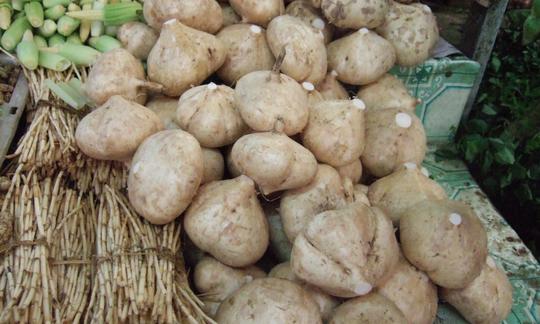


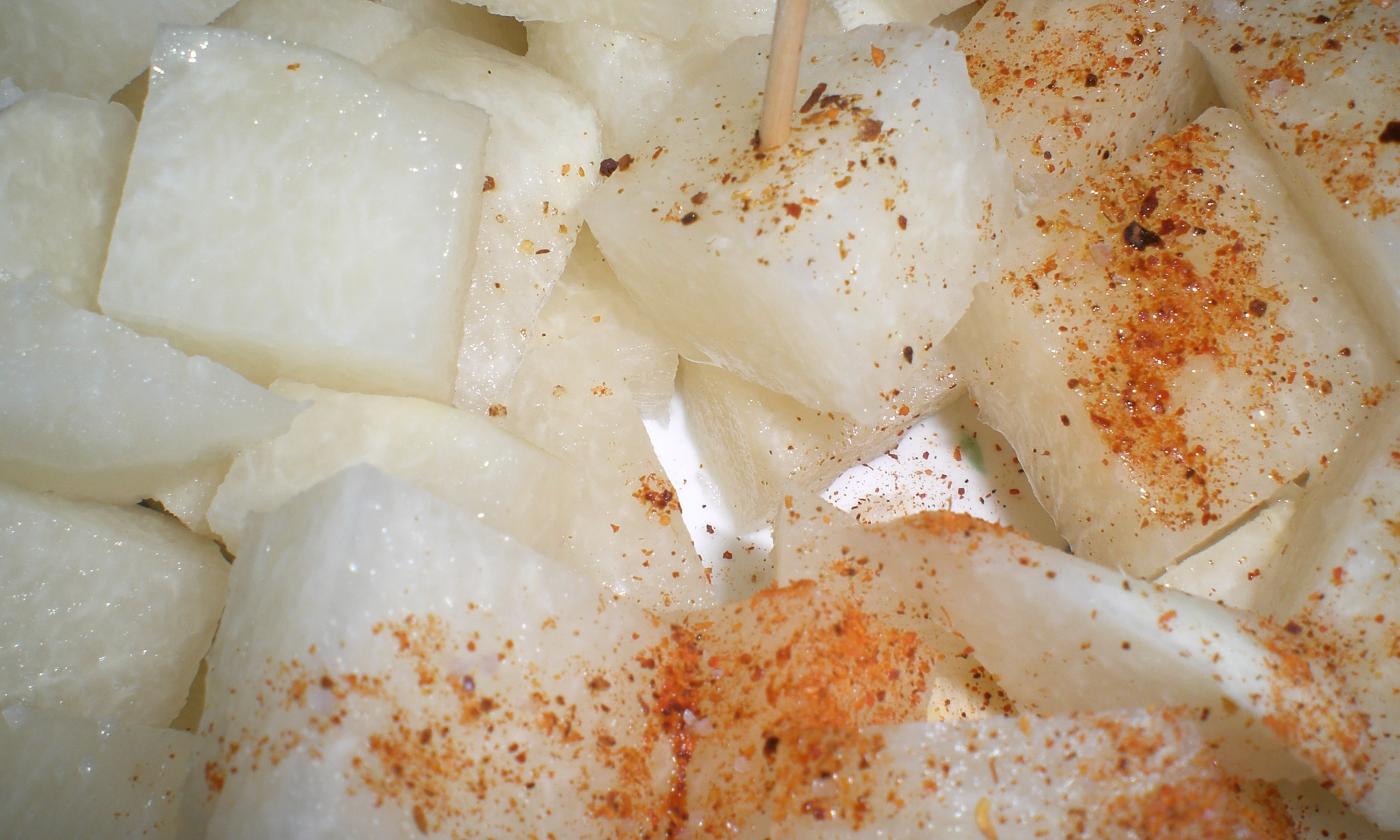
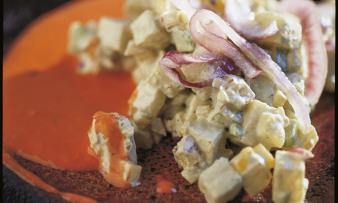
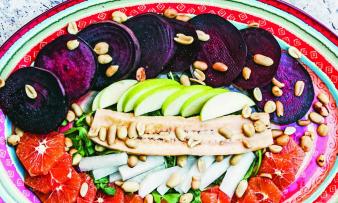
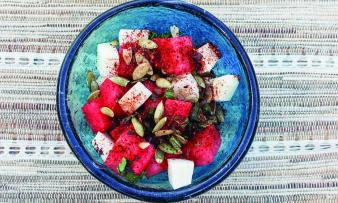





Comments